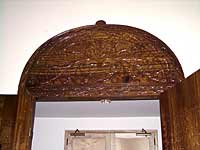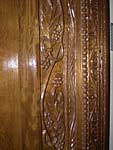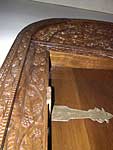Project Tanzania 1985 – 2000
The Zanzibar Doors
| Project Tanzania was an ongoing effort to help people in the East African nation of Tanzania overcome the effects of hunger, drought, and poverty. It was a way for North Carolinians to make a difference in the lives of people in the Shinyanga Region of Tanzania through contributions, personal involvement, and better understanding. |
 |
In 1997, Project Tanzania commissioned a Zanzibar carved wooden door that would serve as a reminder of this successful undertaking. As of the spring of 1997, there were only two known Zanzibar doors in the United States; one at the Smithsonian in Washington, DC and another in the private home of an African archeologist in Florida. Thus, the commissioning of this door represents a unique contribution to the cultural and artistic understanding by the people of North Carolina.
On Thursday, February 24, 2000, this magnificent door was dedicated during a spectacular ceremony and an african dedication dance performed by the Chuck Davis African American Dance Ensemble from Durham, NC. The ceremony was held in Exploris, where the doors will remain.
The Zanzibar Door was carved at the Mikunguni Secondary School in Zanzibar Town, Zanzibar, Tanzania. Mr. Seif Mohammed Seif, the head of the carving department, oversaw the carving of the door during the spring and summer of 1998. The door was designed by Project Tanzania in consultation with Ted Lord, a University of North Carolina-Chapel Hill student staying at the University of Dar es Salaam during the 1997-98 academic year.
Click on the photos for a larger view.
 |
 |
| The door’s arched lintel is typical of Zanzibar doors, as are the characteristic centerpost, double door panels and inscription. Many Zanzibar doors carry inscriptions; these are nearly always on the overhead lintel. Traditional inscriptions are brief Islamic verses written in the Arabic script Swahili. |
 |
However, The doors commissioned by Project Tanzania have the inscription on the inside door panels, instead of in the arched lintel. The inscription is a translation of the Project Tanzania Mission Statement, Project Tanzania is an ongoing effort to help people in the East African nation of Tanzania overcome the effects of hunger, drought, and poverty. It is a way for North Carolinians to make a difference in the lives of people in the Shinyanga Region of Tanzania through contributions, personal involvement, and better understanding. Project Tanzania is a nonprofit organization. |
 |
 |
|
The door is built of mvule wood (Chlorophora excelsa synonymous with Milicia excelsa) brought from the mainland of Tanzania. It was carved primarily by hand using chisels and wooden pounding blocks. The door weighs approximately 400 kilograms (880 lbs).
|